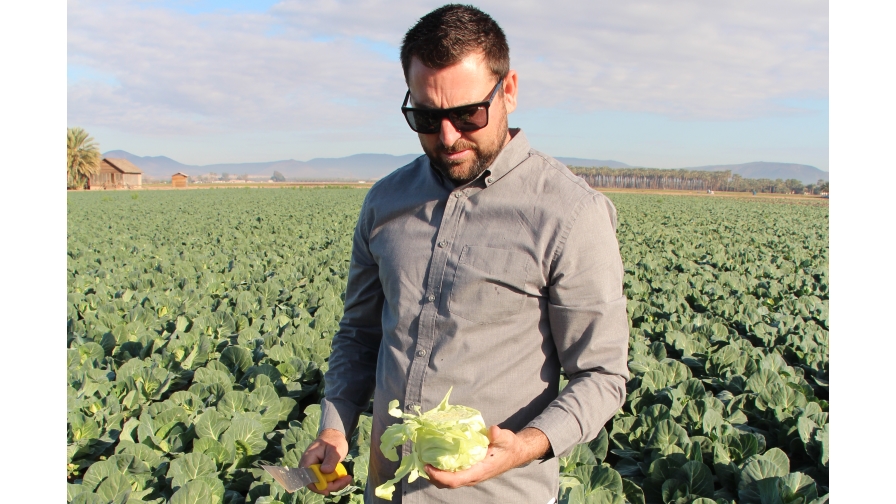Leafy Greens Have a Bright Future

Top Flavor’s Farm Manager Mike Clements offers a taste of a pointed cabbage.
Despite a rough two years for leafy greens, Top Flavor Farms‘ Mike Clements thinks the industry will not only rebound, but thrive.
At first glance, that confidence seems quixotic. 2017 and 2018 had multiple widespread foodborne illness outbreaks linked to romaine. The final one was just before Thanksgiving last year, sparking dark humor and withering comments from consumers no grower wants to hear.
The main outbreak, however, took place in the spring of 2018 and was linked to romaine from the Yuma, AZ, growing area. Five people lost their lives. Top Flavor and its peers in that area have spent the past year re-evaluating their safety standards and doing what they can to prevent any future problem.
So Clements (Top Flavor’s Farm Manager) sees first-hand the lengths growers go to ensure their crops are healthy.
But there’s an additional reason for his positive outlook for the leafy green industry: consumer trends.
“Health and wellness are growing sentiments in our country, and leafy vegetables play a vital role within that. The industry has so many new and exciting products to offer to the consumer,” Clements says.
Increased Safety Measures
The health scares have had an undeniable impact on how growers produce leafy greens.
Grower associations and FDA made recommendations for a safer crop that are already widely adopted, including increased setbacks on borders near livestock, improved traceability, and water testing.
Clements says Top Flavor and other leafy green growers have taken on other upgrades as well:
Irrigation Changes. Ranches have taken on the expense of treating all water that touches crop plant surfaces.
“Anything that is irrigated through overhead sprinklers, it’s being treated,” Clements says. “We’re also changing some of the irrigation methods to configurations that don’t allow the plants to come into contact with water.”
Top Flavor has moved some crops from overhead sprinklers to drip or furrow irrigation.
“That keeps the edible portion of the plant away from direct contact with the water,” he says.
Increased Sampling. Sampling crops and water pre- and postharvest more often is the biggest change spurred by the outbreaks. At Top Flavor, they’ve divvied up the areas tested more finely, and test plots are significantly smaller units than before.
Consumers Want “New”
For all his optimism, Clements admits leafy greens sales are down. He isn’t sure if the outbreaks have driven leafy greens sales down as much as the weather has, at least for growers in the desert Southwest. Its season is late fall to early spring.
“When you have polar vortexes, people don’t want to eat salads. They want warm, hearty food,” he says.
But he’s confident the industry can counter even Mother Nature, if it learns to connect with consumers. His first suggestion is to constantly watch trends.
“We need to keep new and exciting products in front of the consumer and help them get excited about vegetables,” he says.
Americans are exploring taste, textures, and uses of greens. A grower’s job is to keep up.
Top Flavor has ridden the wave of interest in kale over the past five years and is constantly trialing new crops. Some recent hits include baby kale and arugulas. Spinach is growing in popularity again, as are Napa cabbages.
“Anything on the Food Network seems to take off,” he says.
What about romaine?
It will return to pre-outbreak levels, Clements predicts.
“Romaine is still a preferred and versatile leafy green. We do have to show it’s safe, though, and that we are doing everything in our power to make it safe,” he says.
Tackling the Image Problem
Public perception is a huge challenge for the industry, Clements says.
“99.9% of the time our industry is in the news, it is not because of something good,” he says.
He’s hoping producers across the country will start working to change that. Traditionally, there’s a long chain of middlemen between farm fields and store shelves. The work of attracting shoppers to buy vegetables fell to others, so growers concentrated on increasingly sophisticated production.
But too many consumers view modern farming as a problem. Clements argues that if growers remove some of the mystery, it will help build trust — and sales.
“We need to showcase what we are doing on a daily basis. We work in beautiful fields all day; I think consumers would like to see that,” he says.
Clements notes that according to research he’s done, being a farmer is one of the most trustworthy careers. That’s a good foundation to build on.
“They trust us with a huge portion of their well-being. We need to do everything we can to hold on to that trust.”
At a Glance: Top Flavor Farms
Location: Yuma, AZ, Winterhaven, CA, Salinas, CA, and San Juan Bautista, CA
Crops grown in season: Romaine, iceberg, butter and mix lettuces, baby and bunch spinach, spring mix, kale, Napa cabbage, chicory, bok choy, cilantro, beets, cauliflower, broccoli, fennel, radish, parsley, leeks, and several different types of vegetable seed crops including brassica, onions, artichoke, and others.
Crops grown off season: Durum wheat, cotton, Sudan grass, and teff grass. Medjool dates also are grown year-round.









